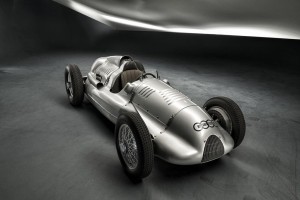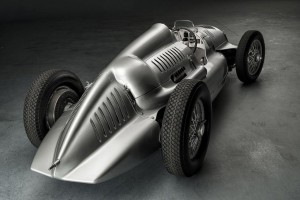Audi purchases an extremely rare Silver Arrows racing car
16 Aug 2012|3,060 views
"This is one of the most emotional moments in our heritage work for AUDI AG – we have come full circle," says Thomas Frank, Head of Audi Tradition.
 The reason personnel from Audi to be full of emotions is because the company has recently made a very valuable repurchase - an extremely rare Auto Union Silver Arrow racing car with mostly original parts. The Auto Union twin-supercharger Type D produced in 1939, is one of only two legendary "Karassik cars". With the purchase Audi now possesses three of the five original Auto Union racing cars that.
The reason personnel from Audi to be full of emotions is because the company has recently made a very valuable repurchase - an extremely rare Auto Union Silver Arrow racing car with mostly original parts. The Auto Union twin-supercharger Type D produced in 1939, is one of only two legendary "Karassik cars". With the purchase Audi now possesses three of the five original Auto Union racing cars that.In 1934, Auto Union and Mercedes-Benz appeared on the international motor racing scene to much success with designs ahead of their time. Unlike most cars Auto Union placed the engine behind the driver, a layout common in today's Formula One cars. Until the outbreak of World War Two in 1939, the Silver Arrows from each German manufacturer dominated racing on Europe's Grand Prix circuits. The 16-cylinder and 12-cylinder racing cars from Zwickau and Stuttgart captured one title after another and the drivers who piloted the sleek silver arrows are still considered racing legends by modern motor sport enthusiasts.
 During the Second World War Mercedes was fortunate enough to rescue almost all its Silver Arrow cars unlike Auto Union which was occupied by the Soviet Army and got the company liquidated and the factories shut down. The Russian forces found the Silver Arrows in a mine building and were carried off to the Soviet Union, losing all trace of the racers thereafter.
During the Second World War Mercedes was fortunate enough to rescue almost all its Silver Arrow cars unlike Auto Union which was occupied by the Soviet Army and got the company liquidated and the factories shut down. The Russian forces found the Silver Arrows in a mine building and were carried off to the Soviet Union, losing all trace of the racers thereafter.At the end of the 1970, rumours were circulating around one Auto Union racing car to be located somewhere in the vast former Soviet Union. Paul Karassik, an American collector of high-class classic vehicles, came to Europe to search for the car who later, immigrated to USA and became wealthy which aided him in his search. After more than ten years and numerous visits, he tracked down the remains of two dismantled Auto Union cars in Russia and Ukraine and bought them.
The engines, chassis, axles and gearboxes were flown to Florida, USA and in May 1991, Paul Karassik made contact with experts from the Audi AG department, who acted as advisors for the planned restoration. Karassiks trusted the rebuilding of their racing cars to the English company Crosthwaite & Gardiner.
"This is one of the most emotional moments in our heritage work for AUDI AG – we have come full circle," says Thomas Frank, Head of Audi Tradition.
The reason personnel from Audi to be full of emotions is because the company has recently made a very valuable repurchase - an extremely rare Auto Union Silver Arrow racing car with mostly original parts. The Auto Union twin-supercharger Type D produced in 1939, is one of only two legendary "Karassik cars". With the purchase Audi now possesses three of the five original Auto Union racing cars that.
In 1934, Auto Union and Mercedes-Benz appeared on the international motor racing scene to much success with designs ahead of their time. Unlike most cars Auto Union placed the engine behind the driver, a layout common in today's Formula One cars. Until the outbreak of World War Two in 1939, the Silver Arrows from each German manufacturer dominated racing on Europe's Grand Prix circuits. The 16-cylinder and 12-cylinder racing cars from Zwickau and Stuttgart captured one title after another and the drivers who piloted the sleek silver arrows are still considered racing legends by modern motor sport enthusiasts.
During the Second World War Mercedes was fortunate enough to rescue almost all its Silver Arrow cars unlike Auto Union which was occupied by the Soviet Army and got the company liquidated and the factories shut down. The Russian forces found the Silver Arrows in a mine building and were carried off to the Soviet Union, losing all trace of the racers thereafter.
At the end of the 1970, rumours were circulating around one Auto Union racing car to be located somewhere in the vast former Soviet Union. Paul Karassik, an American collector of high-class classic vehicles, came to Europe to search for the car who later, immigrated to USA and became wealthy which aided him in his search. After more than ten years and numerous visits, he tracked down the remains of two dismantled Auto Union cars in Russia and Ukraine and bought them.
The engines, chassis, axles and gearboxes were flown to Florida, USA and in May 1991, Paul Karassik made contact with experts from the Audi AG department, who acted as advisors for the planned restoration. Karassiks trusted the rebuilding of their racing cars to the English company Crosthwaite & Gardiner.
Latest COE Prices
April 2025 | 1st BIDDING
NEXT TENDER: 23 Apr 2025
CAT A$97,724
CAT B$117,899
CAT C$68,782
CAT E$117,002
View Full Results Thank You For Your Subscription.
























